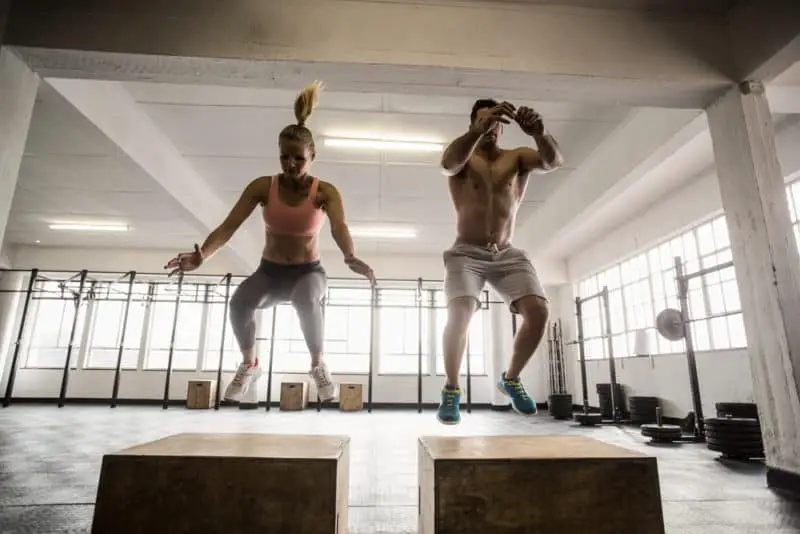Cycling definitely builds athleticism, but do those improvements in your fitness carry over to other activities?
In the strength training world, there’s a great deal of debate about sport-specific exercises: are they necessary, or can most athletes benefit from the same basic movements?
So what if you’re looking to build a particular skill, specifically, improving your vertical jump? Is cycling enough to do it, or should you incorporate other exercises in your fitness plan?
Cycling will improve overall fitness and endurance, which has the potential to improve vertical jump height, but only if you cycle the right way. However, if you’re serious about improving your vertical jump, there are better specific exercises you should be doing as well.
So how do you cycle “the right way,” and what are these other exercises? Read on to find out!
Can Cycling Improve Your Vertical Jump?

Biking covers some of the fundamentals when it comes to increasing your vertical jump, like improving overall fitness and endurance in your lower body. Both of these will help build more athleticism, which is a stepping stone to performing any kind of athletic movement.
However, if you want to get the most vertical jumping potential out of your bike rides, you need to ride the right way. Let me explain.
The vertical jump requires significant lower body power. If you’re using typical metrics such as distance, time or calories burned to track your bike rides, you’re not focusing on training the right energy system to develop more power.
So how can you increase your leg power on your bike? Ride like this instead!
How to Improve Your Jump with Cycling

If vertical jumping is your main goal, it’s time to forget about Strava (don’t worry, you can go back to comparing times with strangers to feed your superiority complex later). Instead, you need to ride to improve leg power.
Your body relies on more than one energy system to perform various athletic functions. For instance, maintaining a consistent pace over the course of a multi-mile ride requires a very different energy system (and much more oxygen) than a 100-meter all out sprint on your bike (which you could do while holding your breath…but shouldn’t!)
A vertical jump uses the latter energy system, which is mostly anaerobic: it doesn’t rely on oxygen as its fuel source, but rather stored ATP instead. If you remember science class from high-school, ATP provides immediate energy to your muscles. However, your body can’t store much of it at any one time, so it’s only good for short-duration activities.
Activities like vertical jumping!
If you want to build power on your bike, you should be doing sprints. A sprint is an all-out effort either a) over a short distance (ex. 100 meters), or b) for a short duration (ex. 10 seconds). Choose one of these two methods (or alternate between them) and perform sprints at the beginning of 1-2 rides a week.
If this is new to you, start off easy by only doing a few every session, with the goal of adding one sprint a week until you’re able to do 8-10. Give yourself enough time in between sprints to almost completely recover, maybe 1-3 minutes depending on your current fitness level.
These can be done on flat ground in a hard gear, but if you really want a challenge, try them on your favorite section of a climb trail.
Rather than adding more sprints, you could add a little time or distance to each one, but not too much: we want to stay in that anaerobic zone to build power. The longer distance or duration the sprints become, the more you’ll need to rely on oxygen, defeating the purpose.
Continue building up your sprinting capacity for four weeks, and then take a week off to recover. During this recovery week, test your vertical jump height and measure your progress. Once the recovery week is over, you can repeat this training block for another four weeks if you enjoyed it (who actually enjoys sprints??) and saw an improvement!
Are Other Exercises Better?
Biking can help, but if you really want to improve your vertical jumping, there are other more effective exercises out there. After all, you don’t see basketball or volleyball players doing a lot of cycling in their training. Let’s take a look at some of them here.
Squats
Squats are the king of lower body exercises. Whether you want to improve strength, power or just build a bigger butt, you should be doing squats.
If you suffer from gym-timidation, not to worry: heavy barbell back squats are great, but they’re not the only type of squat! You can develop significant lower body power doing squats with dumbbells, resistance bands or leg press machines.
Don’t have any equipment whatsoever? Bodyweight squats work too, but make sure you’re being explosive! Get those feet off the ground every rep to maximize your power output. You can jump in place or do broad jumps; both are great bodyweight squat options.
Cleans / High Pulls
Anyone who does Crossfit or Olympic lifting in their training is probably familiar with these exercises. The clean, and its less complex cousin the high pull, are both great for building total body power. They require an immense amount of force to be driven through the glutes to accelerate the barbell.
After getting good at cleans or high pulls with heavy weight, imagine how easy it’s going to feel jumping with just your bodyweight!
While these exercises are some of the best for power development, they are quite technical and take a long time to become proficient. If you think they’re cool and want to learn how to do them, then I encourage you to do so, but if they’re more a means to an end, there are much less challenging options out there without such a steep learning curve.
Trap Bar Deadlifts
One such exercise is the trap bar deadlift. The trap bar (or hex bar given its hexagonal shape) allows you to stand inside it while taking a neutral grip, thereby centering the weight directly underneath you. This makes it a great deadlift choice for people with lower back issues.
The bottom of each rep mimics the bottom of a vertical jump. Driving the weight up with as much force as possible will train your muscles in the exact same movement pattern as when you’re testing your vertical jump, making it a great, less technical alternative to the Olympic lifts mentioned above.
If you don’t have access to a trap bar, you can use two dumbbells held at your sides instead. Since the dumbbells will sit lower to the ground than a barbell and plates, I would advise lifting the dumbbells from raised blocks to limit how far down you need to reach every rep. Full range of motion is important, but this one might be a little too low without blocks.
Depth Jumps
If you want to jump higher, you need to actually jump during training! But let’s make those regular jumps a little more challenging.
To perform a depth jump, you start on a slightly raised bench or platform. Step off the platform and land with both feet positioned in your ideal jumping stance, drop into a squat and then jump as explosively as possible.
Landing in a squat places significant tension on the muscles of your legs, requiring them to overcome greater force to jump. This will build more power than regular jump squats, making the depth jump a great addition to your vertical jump training.
Sprints
Have you ever seen a sprinter without huge legs and a big butt? Probably not, because sprinting is a great lower body strength and power builder!
If you want to move fast and be explosive, you need well-developed quads, glutes and hamstrings. Sprinting helps develop these muscles using the same energy system as vertical jumps (and bike sprints). You can follow the same progression outlined for bike sprints above to steadily add difficulty to your “feet on the ground” training as well.
Time to Take Flight
If you want to jump higher, you’ll need to change up your cycling workouts. But don’t forget to think outside the bike as well! There are a lot of great exercises that will increase lower body strength and power, so do some research or work with a coach to incorporate them into your workouts. If you finally want to be able to hang off that basketball rim (without a step ladder), it’s time to rethink the way you train!
